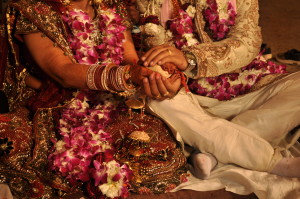Though South Asians are migrating abroad in large numbers these days, people from Gujarat and Punjab were known to have moved earlier to various countries. Punjabi soldiers from the Hong Kong Regiment landed in Canada in 1897 on their way back home after attending Queen Victoria’s diamond jubilee celebration in London. They returned with stories of opportunities offered by the new lush green land of Canada, rich in vegetation which tempted Punjabis, mostly the Sikh Jats (farmers), into making Canada their new home. Determined as they were, nothing prevented them from reaching and settling here, not even the humiliating Komagata Maru episode. In those formative days they, in order to look like other Canadians in public life changed their dress and religious codes; males shorn their hair and women had on skirt, blouse instead of traditional Punjabi ‘salwar-kameez’. At home however they remained attached to their faith, social and cultural traditions as before.
Old values in new world
Here is the saga of these Punjabis from whom neither time nor space could steal their life style. In one of his write ups on Sikhs in Canada, Mr. Hugh Johnston observed, “Rural Punjabis are conscious of several degrees of kinship, ranging from the smallest unit, the ‘tabbar’ or household, containing several generations under one roof, to the ‘pariwar’, a family of several households belonging to all the living males of a single line of descent, and the ‘khandan’, a larger family of many households belonging to male descendants of a common ancestor.
When parents arrange marriages for their children, custom dictates a choice of bride or groom from the same caste but not from the same clan or village. Though a Jat must marry a Jat, a member of the Brar clan of the Jat caste must not marry another Brar.” It is pertinent to add here that the land owned by a ‘parivar’ (household) and the daughters of the family are protected by Jats and other land owning castes at any cost and an evil eye on either invited their wrath against the offender that didn’t wane even after decades because it is a matter of their ‘izzat’ (honor). Members of the Punjabi community though reasonable and cheerful in their social behavior, turn sensitive and conservative at the time of dealing with wedding of their kids. Any marriage taking place outside the defined limits becomes intolerable because family’s ‘izzat’ might get tarnished.
The many honor killings taking place among South Asian communities was testimony to such a bent of mind. Canadian Punjabi children got to know about such clan considerations only at the time of theirmarriage.
Values changing with time
The tradition of selecting a marriage partner for kids on caste basis was firmly upheld by the elders while the younger generation raised here under the liberal western climate often despised that. Evidently any finger raised against established social tradition was hard for the seniors to digest and tempers ran high among various members of family that was previously unknown. But the process of liberalization in choosing marriage partners here accelerated after fresh bands of immigrants who unlike their predecessors were better qualified and with a twenty first century outlook arrived here in the last couple of decades. They brought along liberal marriage trends in-vogue back home but were missing here because of orthodox social approach of earlier migrants. A generation ago, a bride was probably the last person to be consulted before a decision about her marriage was made. But thanks to changed outlook in Punjab that had its ramifications here, now Sikh parents listen more carefully to their children’s preferences and are inclined to leave the final decision to them. Also the bride and groom are given opportunity to become acquainted before their wedding takes place–a phenomenon unheard of before!
Clans put together
Clan and area affiliation was yet another important factor taken into consideration by new immigrants while deciding on the place to settle in Canada. Those from rural areas mostly preferred a Punjabi Sikh society and to socialize within their own caste and relationship. They feel more comfortable among families who were of the same caste and clan, or belong to the same village or within its periphery backhome. In this way immigrants attempt to recreate (and nurture) a back-home environment of ‘shareeka bhaichara’ (fraternity) in Canada. That is why we often come across ads in ethnic newspapers about clubs and associations named after some small village or town in Punjab holding their annual or seasonal get-together in GTA.
In the end
As for Sikhs the general rule to keep uncut hair and wear a turban becomes imperative during a wedding ceremony when families expect a groom to appear at the wedding with a full beard. The modern Punjabi groom normally a clean-shaven, would grow beard for the ceremony and shave if off before the reception that follows. That way the articulate Canadian Punjabi youth would successfully hold a balance between culture of their parents and that of their own generation. He makes east and west meet temporarily in GTA during his wedding ceremony though Rudyard Kipling in one of his famous poems wrote, “Oh East is east and west is west, and never the twain shall meet.
Source: http://www.canindia.com/t9yf5
Disclaimer: News published are collected from various sources and responsibility of news lies solely on the source itself. United Hindu Congress Canada or its website is not in anyway connected nor it is responsible for the news contents presented here.




